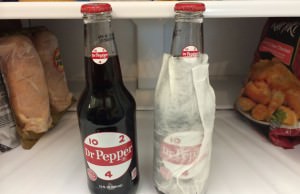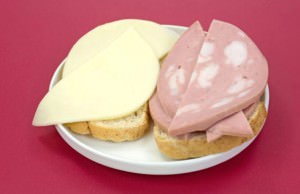21 Worst Foods You Can Eat
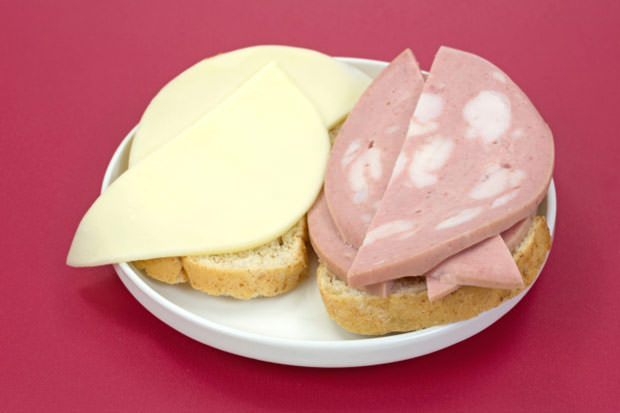
We all know that some foods are bad for us, but the thing we don’t know is just how bad they are. Why shouldn’t we indulge in these guilty pleasures when they taste so delicious?
Part of the answer lies in the question. Unhealthy foods are intentionally made to look and taste a certain way so people would buy them. Although you should probably avoid all the foods on our list, treating yourself to an occasional slice of pizza won’t kill you. Moderation is the key, but some foods can hurt our bodies in more ways than one and experts advise us not to eat them.
Here’s our list of 21 worst foods you can eat:
1. Bologna or Baloney
The famous baloney sandwich actually contains so many harmful ingredients that even one slice of it is bad for our health. Nutritionists say this is one of the foods we should completely avoid.
Baloney can be made from several different types of meat: chicken, turkey, beef, pork, venison or soy protein. That’s great, right? Wrong! Food manufacturers use the “worst” parts of animals in order to cut costs; not to mention the fact that the animals are often mistreated and fed hormones and other chemical concoctions in order to provide the manufacturers with the largest amount of usable parts. You end up eating bones, tails and nails mixed with chemicals to provide the proper color and taste. Mmmmm, yummy.
Another problem is the amount of sodium, with one slice of baloney containing 300 mg of it. The recommended daily intake of sodium should not exceed 2300 mg and with older people that number drops to 1500 mg.
And take a second to think about the proverb ‘You are what you eat’. Do you really feel like a set of chicken nails, eyes, feathers and who knows what else?
Respect your body, it’s your temple, after all.

2. Margarine
You just need to know how Margarine was created and you’ll never eat it again.
Louis-Napoléon Bonaparte (nephew and heir of Napoleon I) or simply Emperor Napoleon III of France offered a prize to anyone who could make a satisfactory alternative for butter. The goal was to manufacture something that’s suitable for long military campaigns. However, margarine originated when the French chemist Michel Eugène Chevreul discovered margaric acid, in 1813. French chemist Hippolyte Mège-Mouriès later invented a substance he called oleomargarine, which achieved little commercial success. In 1871, he sold the patent to the Dutch company Jurgens, now part of Unilever and the rest is history.
As you probably figured out, margarine is no different than plastic or any other product invented by humans in a laboratory.
Margarine contains two different types of fat: the fat from the vegetable oil and the forms of fat created during manufacturing. The vegetable oils are exposed to chemicals, additives, heat, emulsifiers and God knows what else. Each stage in the manufacturing process creates several unwanted by-products.
To sum it up, margarine contains trans fats which:
- Increase the risk of coronary heart disease.
- Lead to unbalanced levels of Omega-3 and Omega-6 fats – more susceptible to cell mutation which can lead to various health problems, cancer being one.
- Decrease the body’s immune response.
- Increase cholesterol – increase the bad cholesterol (LDL) and lowers the good cholesterol (HDL).
- Increase triglyceride levels.
- Lower breast milk quality.
- Increase blood insulin levels – higher risk for diabetes.
- Decrease fertility.
Margarine is at the top of the list when a low fat diet is prescribed, but remember that it was designed as a cheap substitute for butter – it was not designed to be either healthy or nutritious.
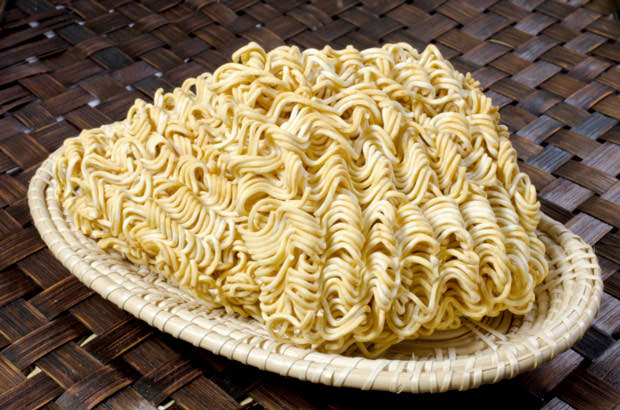
3. Instant noodle
Instant noodles have become quite popular in many countries around the world, including the United States. Apart from being relatively cheap and widely available, they are also easily prepared.
The instant noodle was invented by Momofuku Ando of Nissin Foods in Japan and was launched in 1958 under the brand name Chikin Ramen. The product proved to be quite profitable, but in 1971 Nissin introduced Cup Noodles, a dried noodle block in a polystyrene cup – this was a new beginning. However:
- A single serving of instant noodles is high in carbohydrates and fat, but low in fiber, vitamins and minerals.
- Instant noodles contain substances that reduce the body’s ability to absorb nutrients from healthy foods – affects the digestion process.
- Typical cup-type instant noodles contain 2,700 mg of sodium and the maximum sodium intake per day should be 2,400 mg.
- They are high in MSG (monosodium glutamate) which can trigger cancer.
- Instant noodles contain anti-freeze such as propylene glycol – affects the liver, heart and kidneys.
- Long term consumption can affect the body’s metabolism.
- Instant noodles are a major cause of obesity.
Apart from these health risks, instant noodles are also low in nutritional value – certainly not the best food to prepare for yourself or your family.
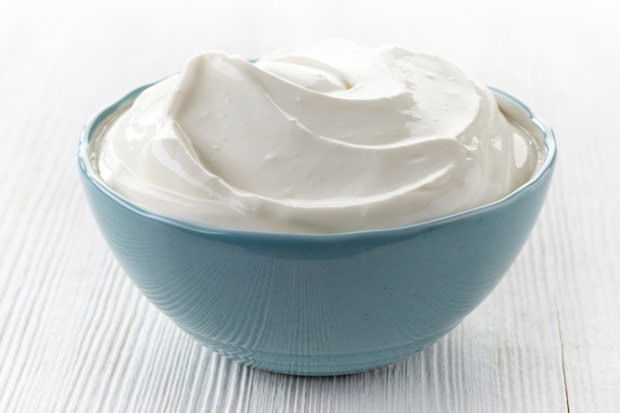
4. Whipped cream
Yes, we know, just by looking at this picture you’re getting a sudden urge to buy and eat large amounts of whipped cream – but you have to control yourself, for your own sake.
Cool Whip contains 12 ingredients, only two of which are not toxic to humans – and water is one of them! According to Wikipedia, the ingredients are: water, hydrogenated vegetable oil, high fructose corn syrup, corn syrup, skim milk, light cream and less than 2% sodium caseinate (a milk derivative), natural and artificial flavor, xanthan and guar gums, polysorbate 60, sorbitan monostearate and beta carotene (as a coloring).
These ingredients can cause:
- Heart disease by increasing bad cholesterol.
- Obesity and diabetes due to the corn syrup.
- Cancer, reproductive disorders and degenerative diseases.
- Autism, brain malfunctions and allergies.
- Diarrhea.
- Skin, eye and respiratory irritations.
Apart from water, the only non-toxic ingredient is beta carotene – now, isn’t that swell?
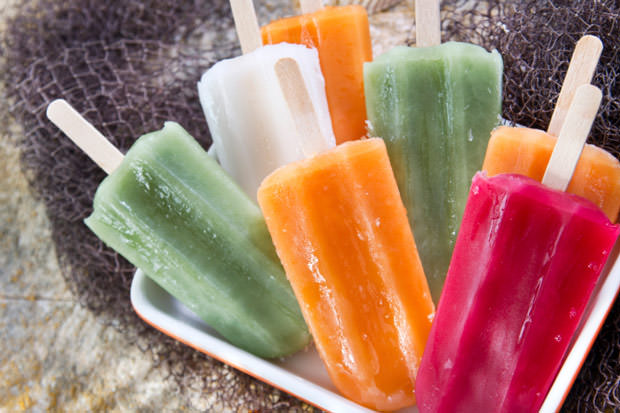
5. Popsicles
Although popsicles are extremely refreshing and more importantly cheap, they are also unhealthy. Try to remember the last time you saw some news article or a discussion about them and you will soon realize that popsicles have avoided scrutiny of the science for almost a century.
They are just water, sugar or high fructose corn syrup, artificial flavors, and dyes, but besides water each of these ingredients is unhealthy, especially in large amounts. Just try to imagine how they look and taste without that artificial color and taste and we think that you will avoid them the next time you’re looking for refreshment.
Although you may tell yourself that popsicles are made with real fruit, don’t fool yourself – they are not the least bit healthy! The fruit is processed and all the nutrients and vitamins disappeared during the process. The flavors and colors have to be added so the popsicles would be palatable.
Additionally, the ‘sugar-free’ version of some popsicles indicates the usage of artificial sweeteners; ‘sugar-free’ doesn’t mean sweetened with fruit juice! Artificial sweeteners can cause a variety of health problems, including cancer. Artificial coloring dye is carcinogenic and artificial coloring can cause allergies.
Popsicles can also seriously damage your teeth; the longer they are exposed to sugar, the greater the damage!
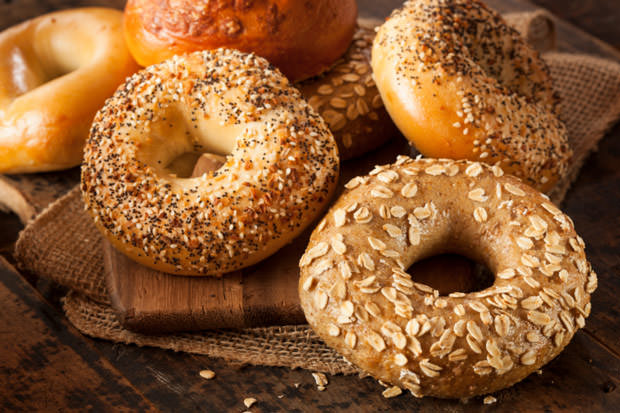
6. Bagels
Bagels look innocent enough, especially if they have cumin or sesame all over them, an indication that they are a healthy and wholesome meal, but the truth is different.
Created in Poland in the 16th century, bagels quickly spread across the world. According to the American Institute of Baking (yes, such an institution exists and they’re quite professional) the sales reached US$626.9 million fresh bagel US supermarket sales (excluding Wal-Mart) in just 52 weeks.
A typical bagel has 260-350 calories, but with various dressings that value increases and leads to the conclusion that exactly four bagels should cover your food intake for an entire day! Sodium, our old friend is again present in extremely high values: 330-660 milligrams per bagel, leading us to another conclusion: if we want to be safe we should eat only two bagels a day. Bagels also contain 50-60g of carbohydrates – equal in carbohydrates to three or four slices of bread. Without fiber and nutrients, they are the definition of empty calories. Unless you plan to exercise after eating bagels, there’s a good chance you’ll put on some extra weight.
The carbohydrates in a bagel quickly convert to sugar and then to fat! Also, since bagels are highly refined, your blood sugar will rise and then drop, which will leave you with little energy.
If you can’t live without bagels, choose whole wheat ones – much better than a white bagel. Combine them with proteins to boost your energy levels and skip the carbs later on during the day. It would also be useful to switch to mini bagels and you’ll automatically cut down on calories and carbohydrates.
If you eat too many bagels, they will definitely harm your health. However, if you choose the right type of bagel, it can be a good breakfast choice.

7. Jelly beans
The Turkish delight, a Middle Eastern sweet made of soft jelly, covered in confectioner’s powder provided the basis for jelly beans and we can trace them back to Boston confectioner William Schrafft, who urged people to send his jelly beans to soldiers during the American Civil War. However, it was not until July 5, 1905 that jelly beans were mentioned in the Chicago Daily News and since then, well, you already know what happened. The basic ingredients of jelly beans include sugar, corn syrup, and pectin or starch. The fun starts when we get to, I guess, advanced ingredients: lecithin, anti-foaming agents, beeswax, salt and confectioner’s glaze.
Not that sugar and corn syrup are healthy, as you’re about to read. Let’s take corn syrup, a substitute for sugar, for an example, and study it further. First of all, in the United States sugar prices are two to three times higher than in the rest of the world, which makes HFCS significantly cheaper: it is the principal sweetener used in processed foods and beverages. Notice the word cheaper in there. Studies have shown that HFCS affects the liver functions, childhood obesity and early death, but that’s not all! A recent study done on Princeton showed that high fructose corn syrup actually does make you gain more weight than the same caloric amount of table sugar.
To make things worse, jelly beans are coated with shellac to make them shiny. Shellac, also known as pharmaceutical glaze or confectioner’s glaze, is recognized as GRAS under the FDA or Generally Recognized as Safe for human consumption. But just because the FDA said it was safe, doesn’t mean you would eat it if you knew how shellac was made. Or to be precise, what it was made from. So, the next time you’re eating jelly beans, remember that shellac is made from the excrement of bugs. In other words, bug poop.
If you are still not disgusted or scared, you should know that orange and purple dyes can impair brain function, while other dyes can cause behavioral problems in kids and ADHD. Scared now?
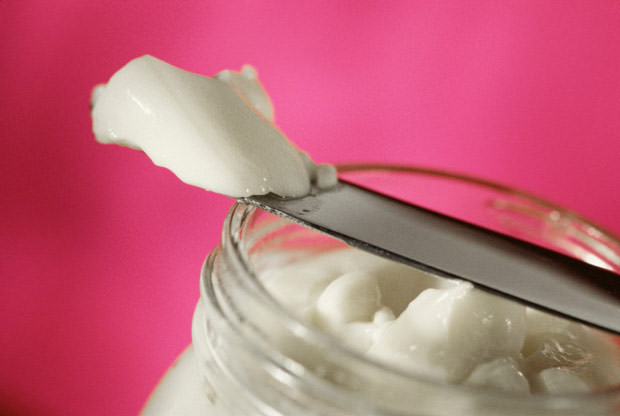
8. Mayonnaise
Mayonnaise is a Spanish sauce containing stable emulsion of oil, egg yolks and either vinegar or lemon juice, with many options for embellishment with other herbs and spices. You’re probably familiar with the fact that you can make your own mayonnaise at home, using ingredients that can be bought in any supermarket. If you eat homemade mayonnaise you’re practically in the clear.
However, commercial mayonnaise contains almost all of the harmful ingredients that we talked about earlier. The list is pretty lengthy: sucrose, high fructose corn syrup, citric acid, thickeners, emulsifiers, EDTA, flavor enhancers. Commercial mayonnaise is most often made with soybean oil, corn oil or other vegetable oil blends that are high in omega-6 fats. This increases the risk of developing heart diseases, cancers, diabetes and osteoporosis. Also, it can cause inflammatory and autoimmune disorders.
Fat-reduced mayonnaise contains a lot of added sugar; regular mayonnaise contains about 1 gram of sugar per tablespoon, while the fat-reduced one has over 4 grams per tablespoon.
When it comes to artificial ingredients, commercial mayonnaise is packed with them: preservatives, additives and monosodium glutamate (MSG).
If you want to avoid health problems that can occur if consummating commercial mayonnaise, it is strongly recommended that you make your own mayonnaise!

9. Bacon
Bacon has a large amount of sodium, and the consumption of a large amount of sodium can put you at risk for heart disease and high blood pressure. Four pieces of bacon can contain up to 800 mg of sodium which is truly a staggering figure.
A study conducted by researchers at the University of Zurich found a connection between eating processed meat and the risk of dying from heart disease or cancer. Diabetes is also around the corner, but more importantly obesity is right in front of us. Obesity not only affects our physical appearance but it also prevents the body from functioning normally and can cause all sorts of health problems.
A second study by researchers at Columbia University found that the consumption of cured meats such as bacon increases a person’s chances of developing chronic pulmonary disease.
It is important to know that only one ounce of bacon contains 30 mg of cholesterol – this can lead to a higher risk of developing heart disease and stroke! People who eat a lot of processed meat are also linked to premature death due to cardiovascular diseases or cancer.
More bad news arrive from the Harvard School of Public Health: researchers say that eating bacon could be linked to a lower sperm count. In addition, nutritionist say that factory-farmed pigs are more likely to get sick than the free-range ones. This means that you are more likely to get sick by eating bacon!
Not to be too harsh on bacon – at least one study suggest that bacon could help cure hangovers. That’s something, right?
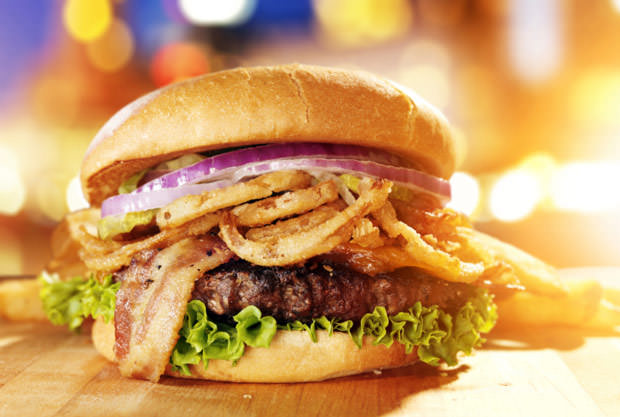
10. Hamburger
Just by looking at this picture of this delicious hamburger, you can spot several items on our list: bacon, mayonnaise and bagel. A combination of duck feathers and human hair through Cysteine makes your burger buns so tasty, and this is only the beginning.
Sand is used when making ground meat so that the meat does not clump up during production. Another interesting fact about the beef patty is the fact that just one patty can contain meat from over one hundred cows! One hundred cows in just one burger, yummy. Also, cows in the United States are given a highly carcinogenic genetically engineered hormone called BGH in order to increase their milk production.
In addition to this, processed meats contain preservatives known as nitrates that, when absorbed by the human body, convert into nitrosamine, a chemical compound that could cause cancer.
Some would say that obesity is the most famous side-effect of hamburger consummation. If you eat a burger in combination with other junk food, your cholesterol level is bound to rise which can be fatal for people already suffering from heart conditions. Another risk on the list is diabetes.
There is also a phenomenon known as the ‘pink slime’, if you aren’t already dissuaded from eating hamburgers. Namely, it is scrap beef, minus the fat, that has been treated with ammonium hydroxide and mixed in the hamburger! Mind you, this chemical is used in cleaning products and fertilizers. Oddly enough, it doesn’t have to be included on the ingredient list because the US Department of Agriculture classified it as a process! Yuck!
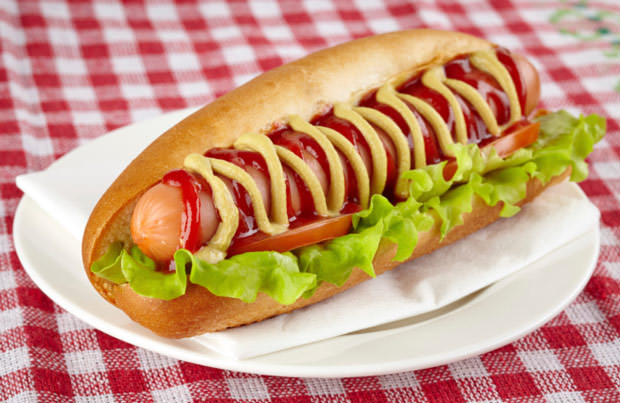
11. Hot dog
Let’s focus on its ingredients:
- Meat trimmings and fat – Pretty much self-explanatory.
- Flavorings – Just let your imaginations run wild with this one.
- Preservatives – This item needs further analysis.
Preservatives are typically sodium erythorbate and sodium nitrite. We already talked about nitrates and various preservatives in our analysis of hamburgers, but this substance is so toxic that it deserves another run.
An American Institute for Cancer Research report found that consuming one 50-gram serving of processed meat, that’s about one hot dog every day, increases risk of colorectal cancer by 20 percent. Processed meats like hot dogs can increase your risk for diabetes, heart disease, and various types of cancer. Processed red meat is especially associated with prostate and ovarian cancer. Consumption of cured and smoked meat can increase children’s risk for leukemia. Hot dogs also contain unhealthy additives which may cause headaches or allergic reactions.
If this isn’t shocking enough, people have reported finding glass, maggots, Band-Aids, bones and even an eyeball in hot dogs!
If you cannot stop eating hot dogs, it is advisable that you don’t consume them every day – treat yourself from time to time – although it would be best to deter yourself from any kind of processed or junk food!

12. Pizza
The next time you want to order a tasty pizza, think about the consequences. Though most people love pizza, nutritionist advise us not to eat it on a regular basis.
While home-made pizza doesn’t necessarily have to be bad for your health, most of the commercially available and frozen pizza on the market is full of artificial dough conditioners and preservatives. Besides, a slice of a regular pizza contains 240 calories. Since it is highly unlikely that anyone would stop after eating only one slice, the calorie count increases according to the number of slices. Basically, you’ll get fat in no time if you eat too much pizza.
The crusts are packed with salt. The sodium level in your pizza is extremely high and a single slice contains 800 mg of sodium. Salt raises blood pressure and hypertension causes strokes, heart failure and heart attacks, the leading causes of death in the United States.
In addition, a slice contains 21 mg of cholesterol, which increases the risk of heart disease.
You should also be careful when choosing toppings. It is never a good idea to opt for mayonnaise or other unhealthy toppings. If possible, choose vegetable toppings. Moderation is they key and it is fine to treat yourself with a slice of pizza from time to time, just be careful not to overdo it.
Last but not least, pizza should never become a part of a child’s daily diet. Children need a varied and healthy diet with lots of vegetables and fruit.

13. French Fries
French fries are one of the unhealthiest foods that people eat on a regular basis. In the United States, about one quarter of the vegetables consumed are fries. The numbers are shocking.
First of all, French fries typically contain trans fats that have been linked to a long list of diseases. Additionally, they contain one of the most potent carcinogenic substances in food—acrylamide. French fries served in American restaurants are often dipped in corn oil and processed corn oil is one of the unhealthiest oils for the human body.
Aside from the bad fat, corn oil has 60 times more inflammatory omega-6 fatty acids than Omega-3s. Mind you, inflammation is a serious factor in various health conditions, including: heart disease, cancer, and arthritis.
A small portion of French fries contains between 200 and 340 calories. The next time you want to order more fries, remember that a large portion has between 370 and 730 calories. Obesity is the most common modern health problem and more than one-third of U.S. adults (34.9%) are obese.
If you can’t cut down on French fries, at least make them at home and they will certainly be healthier than if you order them at a fast food restaurant. However, it is best to completely avoid French fries and choose a healthier alternative.

14. Donuts
Most people just can’t resist donuts. They come in all colors, shapes and sizes and taste absolutely delicious. Since they taste so good, people enjoy eating them and they make us feel good. Unfortunately, donuts are also one of the unhealthiest snacks you can eat. While you can treat yourself with a donut once in a while, we strongly recommend that you completely banish them from your diet and opt for healthier treats.
Most donuts are packed with trans fats that are linked to severe health problems, including cancer and heart-related conditions. Trans fats can increase your cholesterol and triglycerides and lead to various other health conditions.
Additionally, they contain lots of sugar and artificial dough conditioners and food additives. Even the plain doughnuts are high in sugar, but if you choose the ones with glazing, cream or jam, the fat, sugar and calorie numbers drastically rise. Because they have a high sugar content, eating donuts also leads to dental problems. Besides, if you don’t want to get fat, you should definitely cut down on donuts.
The average donut contains about 300 calories.
Most people choose donuts for breakfast because they think donuts are a healthy option. However, since breakfast is the most important meal of the day, eating hundreds of calories and lots of carbohydrates first thing in the morning can only do you harm.
If you want to stay heathy and fit, avoid donuts at all costs.

15. Sausage
Eating too much meat can be very dangerous to a person’s health. However, eating sausages can even be deadly!
Sausages are processed meat and a study examining data from 500,000 people living in 10 European countries discovered that processed meat consumers have a 44 percent higher chance to die prematurely than people who avoid sausages, bacon, burgers etc.
Processed meat is packed with sodium, and usually also contains a lot of saturated fat, which boosts the fat and cholesterol content. There you have it: a recipe for disaster.
Excessive sausage consumption has also been linked to bowel cancer. The World Cancer Research Fund has advised people against eating processed meat and warned us of the possible detrimental consequences.
We are more sure now than ever before that eating processed meat increases your risk of bowel cancer and this is why WCRF recommends that people avoid eating it. When you consider that eating 50g of processed meat a day can increase your risk of bowel cancer by about a fifth, it is clear that you can make a positive difference by cutting out as much as possible. But we need to do more to get this message across because if two-thirds of people don’t know about the link between processed meat and bowel cancer, then they are not in a position to be able to make informed decisions about whether to eat it or not.
Additionally, cured sausages contain sodium nitrite and/or potassium nitrite. They also contain high amounts of salt, which could increase your blood pressure.
All in all, sausages are extremely bad for humans and should be completely avoided. No matter how delicious they are, research has shown that they are dangerous.

16. Frozen dinners
Since we live in such a hectic world, more and more people opt for frozen dinners. And no wonder, they are cheap and easy to prepare. Basically, you have a prepared meal without any effort whatsoever. People work long hours and don’t have the time and the energy to spend hours in the kitchen. Further, there are so many types of frozen dinners in supermarkets that you just have to choose your favorite dish and voila – you can eat it as soon as you get home.
However, have you ever wondered whether frozen dinners are good for you and your family?
Frozen dinners are not healthy if the alternative is a home-prepared meal with unprocessed ingredients. We understand that no one has enough time to cook on a daily basis, but TV dinners can be really bad for your health. TV dinners are way higher in sodium and sugar than home-prepared food. For instance, a portion of macaroni and cheese with beef has 479 milligrams of sodium and 10 grams of sugar.
According to Columbia University, TV dinners can be healthier than some other options, such as ordering a meal from a fast food restaurant or eating a pizza. But, just because they are a better option than other unhealthy foods doesn’t mean you should eat them on a regular basis.
Also, don’t fool yourself that you won’t gain extra weight if you eat frozen dinners that come in portions. Today’s portions are way larger than the portions from just a few years back.
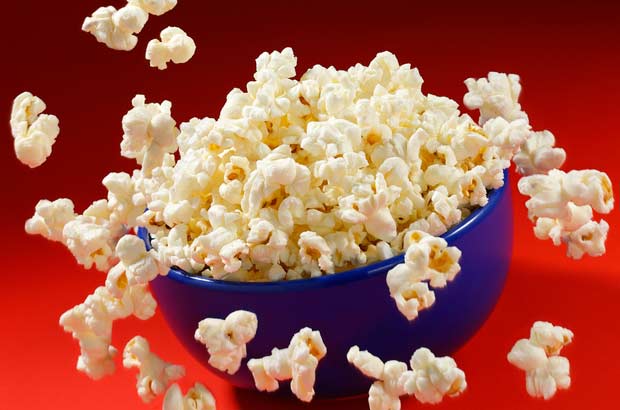
17. Microwave Popcorn
Don’t get us wrong, popcorn can be a healthy snack depending upon how it’s prepared. If you buy popping corn, add a healthy oil and a bit of salt, and pop it yourself, you’ll have a healthy snack to enjoy in front of the TV. Unfortunately, most people don’t prepare popcorn like this. We know no one thinks of such things when going to the movies, but that’s why we have to advise you to avoid popcorn in theatres.
Microwave popcorn is simply packed with chemicals that can seriously harm you and your loved ones.
The popcorn itself is usually coated in preservatives and salt. Additionally, they contain trans fats which can lead to various health conditions. The liquid “butter” is actually artificially flavored oil. Microwavable popcorn bags are coated with perfluorochemicals, a class of chemicals linked to various cancers and reproductive system problems. These chemicals have also been linked to thyroid disease and ADHD. Once ingested, PFCs remain in our bodies for a long time. And there is no way of knowing whether our favorite popcorn brand uses these bags.
Olga Naidenko, PhD, senior scientist at Environmental Working Group explains:
Typically, packaged food manufacturers, organic or otherwise, buy their food packaging from another supplier, and they themselves might not know what is the exact composition of food packaging. Manually popping is still the most reliable method to know exactly what’s in your food.
Since nobody apparently knows what we eat, it would be best to make popcorn on your own.
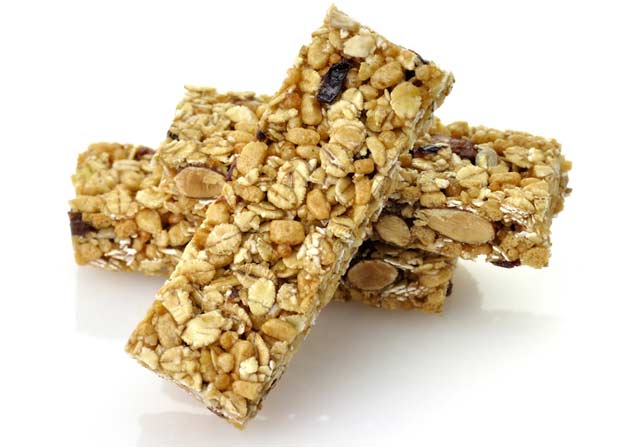
18. Energy Bars
When you see the word ‘energy’ you might assume that these bars are good for your health. According to advertisement they are. They should be the perfect pre-workout snack, but unless you are a professional athlete, you probably don’t need them.
Energy bars are often highly processed products. Even though they may be higher in protein than chocolate bars, they often still contain the same unhealthy ingredients. Many energy bars are filled with high fructose corn syrup, added sugar, and artery-clogging saturated fat. They also have artificial flavor and who knows what else. Additionally, some bars contain more than 350 calories each and you’ll just be getting fat if you consume them.
Nutritionist Heidi Skolnik said:
Some are not much different than candy bars, but they should have less sugar and less fat.
You really have to look at the label. Energy bars are simply a portable way to deliver energy in the form of calories.
Bars contain fortified nutrients, which if you have an energy bar, eight ounces of fortified orange juice and a multi-vitamin for breakfast, you have already overshot many of your nutrient needs for the day. And you can have too many vitamins. Too much vitamin A can lead to liver damage.
To sum it up, you shouldn’t eat energy bars on a regular basis. Not all energy bars are bad for you. There are healthier brands available and it is always important to read the labels carefully. On the other hand, if you are a professional athlete, consult with a physician in order to determine your energy needs.
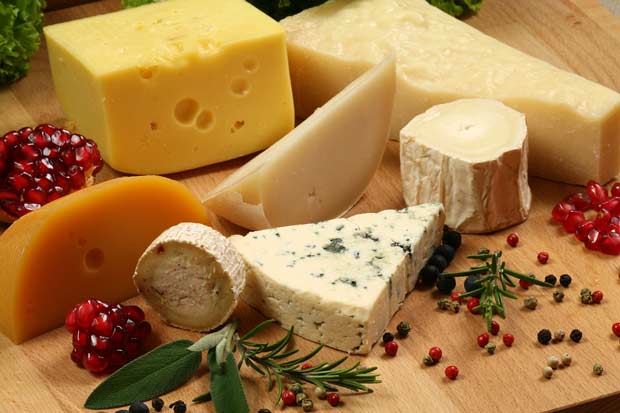
19. Cheese
To make it clear, we aren’t saying every cheese type is bad for our health. However, since Americans consume large amounts of cheese, we have to warn you that some cheese can harm your health. Cheese has some benefits, but people tend to eat it with unhealthy food. If you think that quality cheese poured over nachos will make a difference for your health – it won’t.
On the other hand, cheese alone is bad for our health because it contains high levels of sodium. Sodium retains water in a person’s body and increases blood pressure. Increased blood pressure can lead to serious heart-related conditions and other health problems. Mind you, all heart patients are put on a low-sodium diet.
Be sure to stay away from Cheez Whiz, as that has almost a quarter of the RDA of sodium in just one serving. And even cheeses that are often considered healthy contain a lot of sodium. For example, Feta cheese has about half the daily limit of sodium in a 100 gram serving.
Cheese also has large amounts of saturated fat and cholesterol which could damage your health. It is best to cut down on cheese before a doctor tells you to do so. Cheddar is one of the highest-fat cheeses, which is bad news considering it’s also one of our most popular types of cheese out there.
Before choosing which cheese to include in your regular diet, find out which types of cheese are good for you and which ones you should avoid.
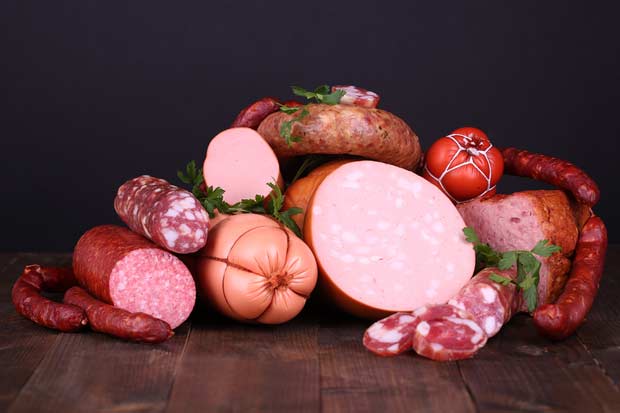
20. Pork Products
Pork is one of the most consumed meats in the world, but research has shown that it is not good for our health.
The amount of cholesterol in many pork products makes them one of the unhealthiest foods in the world. Ribs have a higher cholesterol level than pork chops, and one strip of bacon can have 13mg of cholesterol, not to mention plenty of saturated fat and calories. We have already mentioned bacon, but it seems as though you should seriously cut down on all pork products. Bad cholesterol contributes to plaque, a thick deposit that can clog our arteries. This condition is known as atherosclerosis and if a clot forms and blocks an artery, heart attack or stroke can result.
Additionally, pigs are more saturated with toxins than other animals. This has something to do with the pig’s digestive system because the animals digests whatever it eats very quickly. Further, the pig doesn’t have any sweat glands. Since sweat glands are a tool the body uses to get rid of toxins, the pig is packed with toxins. And when you eat pork, all the toxins from the pig enter your system.
A major concern with eating pork meat is trichinellosis or trichinosis. This is an infection that people get from eating undercooked or uncooked pork that contains the larvae of the trichinella worm. Last but not least, pigs carry many viruses and parasites with them.
We know that pork meat tastes delicious, but the risk is just too high.
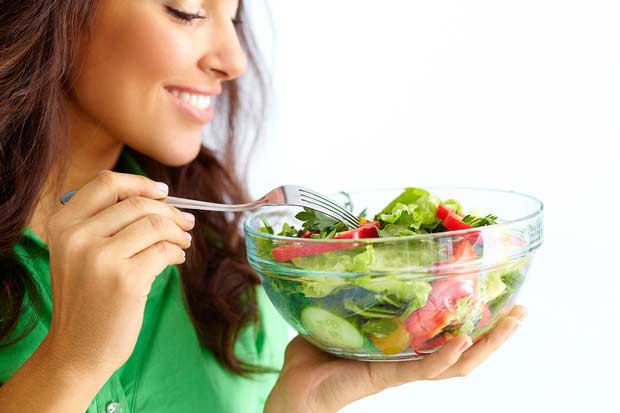
21. Light Foods
Well, people think light foods are healthy because they have fewer calories than their regular counterparts. Of course, advertisers won’t tell us the truth, so many people still believe they are doing themselves a favor by consuming fat-free foods. Truthfully, calorie-free usually means taste-free. We are all aware that the most popular and tastiest food isn’t healthy, so how can we expect fat-free food to be as delicious as food that is packed with calories?
The answer is simple. It just can’t.
However, people wouldn’t buy those products if they didn’t taste good. Food makers have come up with a solution. They add other ingredients — especially sugar, flour, thickeners, and salt — into the products. The light foods then taste excellent and everyone is happy? Wrong.
Those products will have more calories when all the other ingredients are added. Besides, food makers add artificial sweeteners which can be very harmful to humans. Since they are toxic, they can lead to numerous health problems and conditions. It is best to completely avoid food that has artificial sweeteners.
Finally, if you want to be healthy and fit, you need to choose healthy foods. Instead of opting for light foods, eat vegetables or fruits. Home-prepared meals are always a good option, but even if you don’t have enough time to cook every day, there is a number of healthy alternatives you can buy in stores and restaurants.
Also remember that it is more important that you eat food with good fat than fat-free products.


